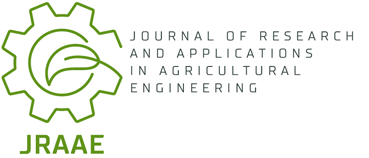Current issue
Online First
Archive
Instructions for Authors
Guide for Authors
Peer Review Policy
Research Ethics Policy
Crossmark Policy
Ghostwriting and Guest Authorship
Copyright
Open Access Policy
Plagiarism
About the Journal
Aim and Scope
Scientific Board
Publisher
Editorial Board
Indexing in Databases
Personal Data Protection
Repository Policy
Contact
ORIGINAL PAPER
The influence of the density of the mass flux of the densified material and the rotational speed of the matrix on the power consumption of the pellet mill and the quality of obtained pellets
1
Białystok University of Technology, Faculty of Civil and Environmental Engineering, Department of Agricultural and Food Techniques, ul. Wiejska 45E, 15-351 Białystok, Poland
2
Białystok University of Technology, Faculty of Civil and Environmental Engineering, Department of Chemistry, ul. Wiejska 45E, 15-351 Białystok, Poland
Journal of Research and Applications in Agricultural Engineering 2015;60(1):59-62
KEYWORDS
ABSTRACT
The article presents tests of the influence of the density of the mass flux of the densified material (5.29, 6.80, and 8.31 kg/m2•s) and the
influence of the rotational speed of the matrix (280, 330, and 380 r•min-1) on the power consumption of the pellet mill and the quality of obtained
pellets. The tests were carried out on a SS-2 stand with a working system of a pellet mill with a rotating matrix. On the basis of performed
tests it was concluded that an increase in density of the mass flux of densified material and an increase in rotational speed of the
matrix cause an increase in power consumption of the device and a reduction of the density and kinetic durability of obtained pellets.
REFERENCES (24)
1.
Czaban J.: Ciśnieniowa aglomeracja pasz w układzie roboczym granulatora. Praca doktorska. Politechnika Białostocka, 2000.
2.
Demianiuk L.: Brykietowanie rozdrobnionych materiałów roślinnych. Praca doktorska. Politechnika Białostocka, Białystok, 2001.
3.
Ekielski S.: Podstawy energooszczędnego formowania suszu z zielonek. Prace Naukowo-Badawcze IBMER, 1994.
4.
Grover P.D., Mishra S.K.: Biomass briquetting: technology and practices, Regional Wood Energy Development Programme in Asia, field document no. 46, Food and Agriculture Organization of the United Nations, Bangkok, Thailand, 1996.
5.
Heinemans H.: The interaction of practical experience and the construction of new pelleting and cooling machinery. Advances in Feed Tech, 1991, 6: 24-38.
6.
Hejft R.: Ciśnieniowa aglomeracja pasz i podstawy konstrukcji urządzeń granulująco-brykietujących. Rozprawy Naukowe Politechniki Białostockiej, nr 11, Białystok, 1991.
7.
Hejft R.: Ciśnieniowa aglomeracja materiałów roślinnych. Biblioteka Problemów Eksploatacji. ITE Radom, 2002.
8.
Hill B, Pulkinen D.A.: A study of the factors affecting pellet durability and pelleting efficiency in the production of dehydrated alfalfa pellets. Saskatchewan, Canada: Saskatchewan Dehydrators Association, 1988.
9.
Inghelbrecht S, Remon JP.: The roller compaction of different types of lactose. International Journal of Pharmaceutics, 1998, 166, 135-44.
10.
Kaliyan N., Morey R.V.: Factors affecting strength and durability of densified biomass products. Biaomass and Bioenergy, 2009, 33, 337-359.
11.
Laskowski J., Skonecki S.: Wpływ parametrów komory i masy materiału na zagęszczanie nasion łubinu. Inżynieria Rolnicza, 2005, Nr 7(67), 101-108.
12.
Laskowski J., Skonecki S.: Wpływ średnicy komory i masy próbki na zagęszczanie poekstrakcyjnej śruty rzepakowej. Inżynieria Rolnicza. 2006, Nr 6 (81), 15-23.
13.
Obidziński S., Hejft R.: Wpływ parametrów aparaturowo-procesowych na naciski zagęszczające w procesie granulowania pasz. Inżynieria Rolnicza, 2007, 5(93), 313-319.
14.
Obidziński S., Hejft R.: Wpływ parametrów techniczno-technologicznych procesu granulowania pasz na jakość otrzymanego produktu. Journal of Research and Applications in Agricultural Engineering, 2012, Vol. 57 (1), 109-114.
15.
Obidziński S.: The evaluation of the power consumption of the pellets production process from the plant materials”. TEKA Kom. Mot. Energ. Roln., 2013, Vol. 13, No. 2, 73-78.
16.
Obidzinski S.: Utilization of post-production waste of potato pulp and buckwheat hulls in the form of pellets. Polish Journal of Environmental Studies, 2014, Vol. 23, 1391-1395.
17.
Pietsch W.: Granulate dry particulate solids by compaction and retain key powder particle properties. Chemical Engineering Progress, 1997, April: 24-46.
18.
Stevens C.A.: Starch gelatinization and the influence of particle size, steam pressure and die speed on the pelleting process. Ph.D. dissertation. Kansas State University, 1987.
19.
Tabil Jr L, Sokhansanj S.: Process conditions affecting the physical quality of alfalfa pellets. Applied Engineering in Agriculture, 1996, 12, 345350.
20.
Thomas M., Van Zuilichem D.J., Van Der Poel A.F.B.: Physical quality of pelleted animal feed. 2. Contribution of processes and its conditions. Animal Feed Science Technology, 1997, 64, 173-192.
21.
Tamuluru J.S.: Effect of process variables on the density and durability of the pellets made from high moisture corn stoper. Biosystems Engineering 2014, 119, 44-57.
22.
Walczyński S.: Porównanie metod oznaczania wytrzymałości kinetycznej granulatów. Pasze Przemysłowe, 1997, Nr 11/12, 17-19.
23.
Walczyński S.: Niektóre właściwości surowców i mieszanek paszowych oraz metody ich oznaczania. Pasze Przemysłowe, 2001, Nr 2/3, 7-9.
24.
Yoshida T., Sasaki H., Takano T., Sawabe O.: Dewatering of highmoisture wood chips by roller. Biomass and Bioenergy, 2010, 34, 1053-1058.
Share
RELATED ARTICLE
We process personal data collected when visiting the website. The function of obtaining information about users and their behavior is carried out by voluntarily entered information in forms and saving cookies in end devices. Data, including cookies, are used to provide services, improve the user experience and to analyze the traffic in accordance with the Privacy policy. Data are also collected and processed by Google Analytics tool (more).
You can change cookies settings in your browser. Restricted use of cookies in the browser configuration may affect some functionalities of the website.
You can change cookies settings in your browser. Restricted use of cookies in the browser configuration may affect some functionalities of the website.


